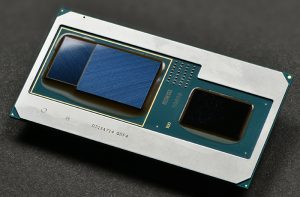Article
AMD Ryzen CPUs with integrated Vega graphics are great for budget-friendly PC gaming | Windows Central
My Comments

Highly-portable computers of the same ilk as the Dell Inspiron 13 7000 2-in-1 will end up with highly-capable graphics infrastructure
A major change that will affect personal-computer graphics subsystems is that those subsystems that have a highly-capable graphics processor “wired-in” on the motherboard will be offering affordable graphics performance for games and multimedia.
One of the reasons is that graphics subsystems that are delivered as an expansion card are becoming very pricey, even ethereally expensive, thanks to the Bitcoin gold rush. This is because the GPUs (graphics processors) on the expansion cards are being used simply as dedicated computational processors that are for mining Bitcoin. This situation is placing higher-performance graphics out of the reach of most home and business computer users who want to benefit from this feature for work or play.
But the reality is that we will be asking our computers’ graphics infrastructure to realise images that have a resolution of 4K or more with high colour depths and dynamic range on at least one screen. There will even be the reality that everyone will be dabbling in games or advanced graphics work at some point in their computing lives and even expecting a highly-portable or highly-compact computer to perform this job.
Integrated graphics processors as powerful as economy discrete graphics infrastructure
One of the directions Intel is taking is to design their own integrated graphics processors that use the host computer’s main RAM memory but have these able to serve with the equivalent performance of a baseline dedicated graphics processor that uses its own memory. It is also taking advantage of the fact that most recent computers are being loaded with at least 4Gb system RAM, if not 8Gb or 16Gb. This is to support power economy when a laptop is powered by its own battery, but these processors can even support some casual gaming or graphics tasks.
Discrete graphics processors on the same chip die as the computer’s main processor

This Intel CPU+GPU chipset will be the kind of graphics infrastructure for portable or compact enthusiast-grade or multimedia-grade computers
Another direction that Intel and AMD are taking is to integrate a discrete graphics subsystem on the same chip die (piece of silicon) as the CPU i.e. the computer’s central “brain” to provide “enthusiast-class” or “multimedia-class” graphics in a relatively compact form factor. It is also about not yielding extra heat nor about drawing on too much power. These features are making it appeal towards laptops, all-in-one computers and low-profile desktops such as the ultra-small “Next Unit of Computing” or consumer / small-business desktop computers, where it is desirable to have silent operation and highly-compact housings.
Both CPU vendors are implementing AMD’s Radeon Vega graphics technology on the same die as some of their CPU designs.
Interest in separate-chip discrete graphics infrastructure

The Dell Inspiron 15 7000 Gaming laptop – the kind of computer that will maintain traditional soldered-on discrete graphics infrastructure
There is still an interest in discrete graphics infrastructure that uses its own silicon but soldered to the motherboard. NVIDIA and AMD, especially the former, are offering this kind of infrastructure as a high-performance option for gaming laptops and compact high-performance desktop systems; along with high-performance motherboards for own-build high-performance computer projects such as “gaming rigs”. The latter case would typify a situation where one would build the computer with one of these motherboards but install a newer better-performing graphics card at a later date.

Sonnet eGFX Breakaway Puck integrated-chipset external graphics module – the way to go for ultraportables
This same option is also being offered as part of the external graphics modules that are being facilitated thanks to the Thunderbolt 3 over USB-C interface. The appeal of these modules is that a highly-portable or highly-compact computer can benefit from better graphics at a later date thanks to one plugging in one of these modules. Portable-computer users can benefit from the idea of working with high-performance graphics where they use it most but keep the computer lightweight when on the road.
Graphics processor selection in the operating system
For those computers that implement multiple graphics processors, Microsoft making it easier to determine which graphics processor an application is to use with the view of allowing the user to select whether the application should work in a performance or power-economy mode. This feature is destined for the next major iteration of Windows 10.
Here, it avoids the issues associated with NVIDIA Optimus and similar multi-GPU-management technologies where this feature is managed with an awkward user interface. They are even making sure that a user who runs external graphics modules has that same level of control as one who is running a system with two graphics processors on the motherboard.
What I see now is an effort by the computer-hardware industry to make graphics infrastructure for highly-compact or highly-portable computers offer similar levels of performance to baseline or mid-tier graphics infrastructure available to traditional desktop computer setups.

The trends affecting personal-computer graphics infrastructure
Article
AMD Ryzen CPUs with integrated Vega graphics are great for budget-friendly PC gaming | Windows Central
My Comments
Highly-portable computers of the same ilk as the Dell Inspiron 13 7000 2-in-1 will end up with highly-capable graphics infrastructure
A major change that will affect personal-computer graphics subsystems is that those subsystems that have a highly-capable graphics processor “wired-in” on the motherboard will be offering affordable graphics performance for games and multimedia.
One of the reasons is that graphics subsystems that are delivered as an expansion card are becoming very pricey, even ethereally expensive, thanks to the Bitcoin gold rush. This is because the GPUs (graphics processors) on the expansion cards are being used simply as dedicated computational processors that are for mining Bitcoin. This situation is placing higher-performance graphics out of the reach of most home and business computer users who want to benefit from this feature for work or play.
But the reality is that we will be asking our computers’ graphics infrastructure to realise images that have a resolution of 4K or more with high colour depths and dynamic range on at least one screen. There will even be the reality that everyone will be dabbling in games or advanced graphics work at some point in their computing lives and even expecting a highly-portable or highly-compact computer to perform this job.
Integrated graphics processors as powerful as economy discrete graphics infrastructure
One of the directions Intel is taking is to design their own integrated graphics processors that use the host computer’s main RAM memory but have these able to serve with the equivalent performance of a baseline dedicated graphics processor that uses its own memory. It is also taking advantage of the fact that most recent computers are being loaded with at least 4Gb system RAM, if not 8Gb or 16Gb. This is to support power economy when a laptop is powered by its own battery, but these processors can even support some casual gaming or graphics tasks.
Discrete graphics processors on the same chip die as the computer’s main processor
This Intel CPU+GPU chipset will be the kind of graphics infrastructure for portable or compact enthusiast-grade or multimedia-grade computers
Another direction that Intel and AMD are taking is to integrate a discrete graphics subsystem on the same chip die (piece of silicon) as the CPU i.e. the computer’s central “brain” to provide “enthusiast-class” or “multimedia-class” graphics in a relatively compact form factor. It is also about not yielding extra heat nor about drawing on too much power. These features are making it appeal towards laptops, all-in-one computers and low-profile desktops such as the ultra-small “Next Unit of Computing” or consumer / small-business desktop computers, where it is desirable to have silent operation and highly-compact housings.
Both CPU vendors are implementing AMD’s Radeon Vega graphics technology on the same die as some of their CPU designs.
Interest in separate-chip discrete graphics infrastructure
The Dell Inspiron 15 7000 Gaming laptop – the kind of computer that will maintain traditional soldered-on discrete graphics infrastructure
There is still an interest in discrete graphics infrastructure that uses its own silicon but soldered to the motherboard. NVIDIA and AMD, especially the former, are offering this kind of infrastructure as a high-performance option for gaming laptops and compact high-performance desktop systems; along with high-performance motherboards for own-build high-performance computer projects such as “gaming rigs”. The latter case would typify a situation where one would build the computer with one of these motherboards but install a newer better-performing graphics card at a later date.
Sonnet eGFX Breakaway Puck integrated-chipset external graphics module – the way to go for ultraportables
This same option is also being offered as part of the external graphics modules that are being facilitated thanks to the Thunderbolt 3 over USB-C interface. The appeal of these modules is that a highly-portable or highly-compact computer can benefit from better graphics at a later date thanks to one plugging in one of these modules. Portable-computer users can benefit from the idea of working with high-performance graphics where they use it most but keep the computer lightweight when on the road.
Graphics processor selection in the operating system
For those computers that implement multiple graphics processors, Microsoft making it easier to determine which graphics processor an application is to use with the view of allowing the user to select whether the application should work in a performance or power-economy mode. This feature is destined for the next major iteration of Windows 10.
Here, it avoids the issues associated with NVIDIA Optimus and similar multi-GPU-management technologies where this feature is managed with an awkward user interface. They are even making sure that a user who runs external graphics modules has that same level of control as one who is running a system with two graphics processors on the motherboard.
What I see now is an effort by the computer-hardware industry to make graphics infrastructure for highly-compact or highly-portable computers offer similar levels of performance to baseline or mid-tier graphics infrastructure available to traditional desktop computer setups.
Related Posts
Designing for highly-compatible Internet Of Things
You can start and stop Google Chromecast with your TV’s remote
Showdown on the handheld front
About The Author
simonmackay